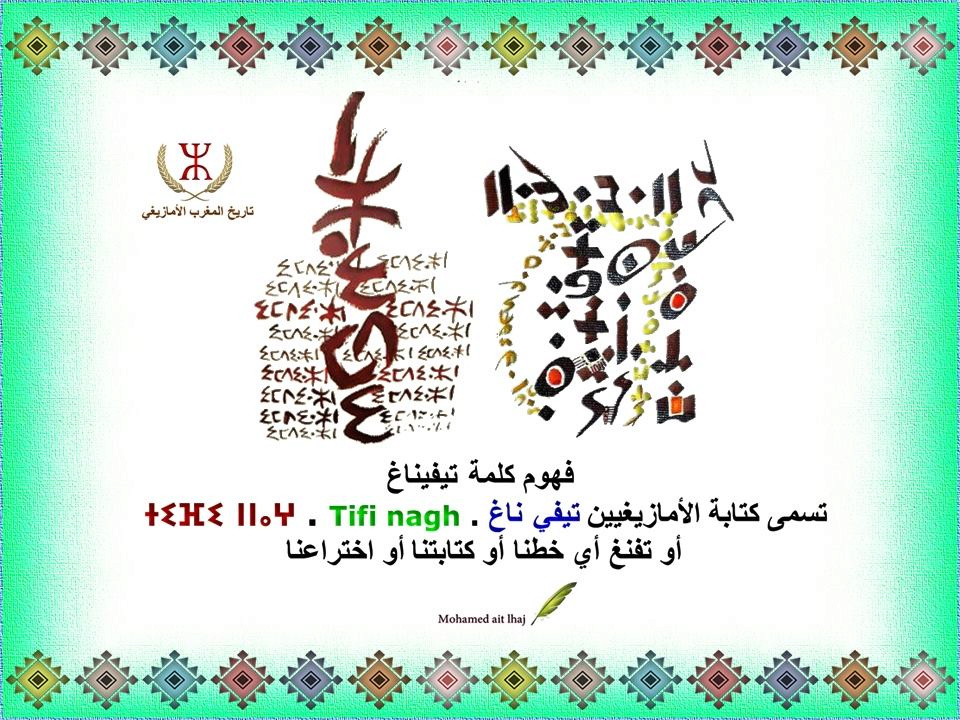Tifinagh ⵜⵉⴼⵉⵏⴰⵖ is an ancient alphabet

Tifinagh ⵜⵉⴼⵉⵏⴰⵖ is an ancient alphabet that was used in North Africa among the Amazighs to write down the various Amazighe languages. It is an alphabet that is believed to be of Phoenician origin, but it has been proven that it is older than the Phoenician alphabet. The oldest form of this alphabet has been documented in the Libyan language.
From the third century BC until the third century AD throughout North Africa. This alphabet has witnessed several modifications and names since its inception until the present day, such as Libyan Tifinagh, Amazigh Saharan Tifinagh, and Tuareg Tifinagh.
Etymology
The term Tifinagh is derived from the linguistic root (fn g), which refers to the word [fnaq], which is of its origin from the Phoenician alphabet, and was originally pronounced with the qāf, meaning tifināq.
Since the letters qāf and ghān stand in for each other, the qāf in this pronunciation has been replaced by two adults to facilitate the pronunciation process. French General Louis-Joseph Hanouto, a specialist in tribal linguistic studies, says:
“The naming of the Tifinagh alphabet alone exposes its Phoenician origin. Fatfinagh is a mu’nat noun in the plural form, singular is Tafniqt, meaning Phoenician.”

The French historian Jean Servier reminds him that the derivation of the word Tifinagh is “Tifi” and “Ng” (“Tifi” means discovery in Amazigh) with “Ng” being equivalent to “our discovery”, which means “our discovery” in the Amazigh language. Based on this belief, the theorist of the Amazigh movement, Muhammad Shafiq, insists on its locality: “These letters are called Tifinagh, and this name has been given various interpretations, the quickest to mind is that the word is derived from (Phoenicia, Phenicia) and so on. This may match the origin of this name, but what is certain is that the Amazigh writing is not copied from it. Rather, it is likely to be believed that it and the Phoenician belong to very ancient models related to the letters that were discovered in the south of the Arabian Peninsula. He also says: “Between the Tifinagh letters, both ancient and Tawark, and the Himyarite letters, there is a noticeable similarity in shapes. However, they do not coincide in the casting of votes, except in two cases in which there is a violation of scrutiny.”
The ancient Libyans had their own script, which was Tifinagh. Until recently, it was believed that it was a Phoenician script that appeared in the second century BC thanks to Masinissa. However, the Algerian researcher was able to find plaques written on it in Tifinagh. The researcher in question here is Malika Hashid, a historian and archaeologist who conducted examinations on the found Tifinagh and found that it dates back to one thousand five hundred years BC, that is, before the Phoenicians came to North Africa (813 BC), which made some believe that Tifinagh is the oldest. The phonetic writings known to man.
The plaque bearing the Tifinagh letters is one of the plaques accompanying horse chariots. This type of chariot appeared in the era between one thousand years BC and one thousand five hundred years BC, which made Gabriel Camps believe that Tifinagh could not have appeared at a time less ancient than a thousand years before. Birth.
Although there are several hypotheses about the origin of Tifinagh, starting from the Phoenician origin to the local ancient Libyan origin, the research has not yet settled on a situation, which is what Gabriel Camps and Karl Presse summarize by saying that despite all attempts at classification, knowledge of the origin of Tifinagh remains elusive.
Tifinagh is a little-known writing, but it is old enough to deserve attention, considering that primitive Tifinagh dates back almost three thousand years BC. It seems that this writing, called primitive Tifinagh or primitive Libyan writing, appeared with the Homo sapiens, in reference to the Tunisian city of Gafsa. So that Tifinagh appeared as primitive, readable drawings, and some even made them readable letters.

The remains of Tifinagh are spread in North Africa, the Canary Islands, and the Iberian Peninsula. If the previous sources for the discovery of the Tifinagh alphabet, which made it ancient, date back to at least a thousand years BC, but rather to one thousand five hundred BC, according to archaeologist Malika Hashid and other researchers. The resulting circumstances, such as making some of the less ancient alphabets originally Tifinagh, have deprived it of much of the importance it might have deserved, such that it was made a product of two hundred years BC at best. The discovery has made many researchers reconsider their calculations and wonder about the origins of some of the alphabets that I believe are Phoenician because the Phoenician alphabet is considered the oldest of the alphabets. An example of this is the research carried out by Mubarak Salouti Takelet on whether the Latin letters were originally Amazigh letters.
Source: websites

